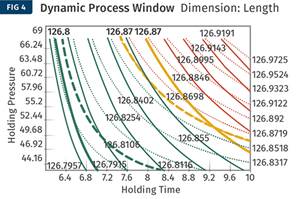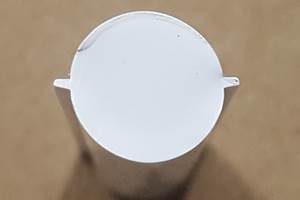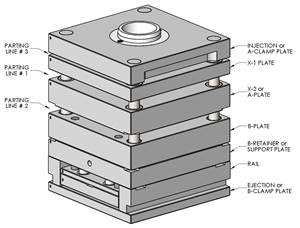Get Better at Using Foam for Your Molded Parts
Machine performance and process speeds are critical when using foam to reduce part weight while retaining part integrity.
You’ve heard about the benefits of foaming injection molded parts — such as using less resin to reduce weight while retaining part integrity — but you’re not sure how to take the first step.
Molders and other processors have added foaming to their repertoire, with great success, since the 1980s. When it comes to foaming injection molded parts, there are a few key things that will help to determine successful results.
Keep in mind, foam turns a high-pressure machine into a low-pressure process. Weights and cycles will be determined by how much foam you can get into the wall. At some point, it won’t matter how much foam you add —the injection speed will only allow so much gas in the wall.
Pallets and other big parts have been foamed for years. More recently, processors want to foam thin-wall parts — drinking cups and closures, for example — with Class A surfaces. This is why molds are important; for instance, whether you’re using a stack tool, family tool or multicavity tool. Other parts that are commonly foamed include water meter boxes, automotive bumpers, door panels and grab handles, golf discs and more. They each have their own specific challenges for achieving foaming success.

Molders have been using foam for decades on pallets and other big parts, but of late have been looking at applying the technology to thin-walled packing such as cups. Source: iD Additives
No matter the product you’re foaming, machine performance is the most crucial parameter to dial in from the start, with injection speed being a key component of that. For instance, If you are producing an eight-cavity aerosol cap and it takes two seconds to fill the part, you won’t be able to foam the part aesthetically unless you can inject faster — at a rate of 0.2 to 0.3 seconds.
Your choice of injection velocity is another key factor in how much foam you will need. If the part is aesthetic, faster fill means more foam can be added to create lighter parts. If you see splay on the surface, there is too much foam at your current speed, so you must reduce the amount of foam until splay is gone and the part is clean. If the part is non-aesthetic, faster fill will give you maximum weight and maximum cycle time savings.
Answer the Initial Questions
When consulting a vendor on a foaming project, begin by asking a series of key questions about the equipment to be used and current processing parameters that will be adjusted to optimize the foam’s effect in each application.
For starters, it doesn't really matter whether you’re using all-electric or hybrid molding machines — but if you’ve got older hydraulic machines from the 1970s and ‘80s on the floor, those most likely won’t work. It all depends on fill speed. For instance, some machines have accumulators that enable very fast injection speed. Electric machines typically can also provide fast injection.

Caps and closures are another example of foam moving into thin-wall packaging parts.
From the outset, you have to know how fast you can fill, because that's going to determine what foam product to use. For instance, if you're injecting at three inches per second, you will need a 20-cc foam, because a 35-cc foam contains too much gas.
You’ll also need to know:
• Is weight more important than cycle time?
• What are your barrel temperatures?
• How many shots are in the barrel ?
• Percentage of barrel.
• Is the part aesthetic or not — meaning splay or no splay on the surface?
Think about foam in a barrel: Imagine you have a one-minute cycle with 10 shots in the barrel; that’s 600 seconds for that foam to hit the screw and get to the mold. In that situation, you need to start dropping barrel temperatures to get them as cool as you can to control the foam. This will avoid prefoaming and splaying the surface on 1/4% letdown — which is hardly significant, but because it’s prefoaming and activating, you lose control of the process and the foam’s benefit.
Understand Your Tools
Foaming molded parts is as much art as science. Take a stack tool on the screw bar, for instance. Many people run that screw bar at about 380°F or 390ºF — but you only need to run at about 320ºF.
Understanding how specific tools behave is a key factor in success. Here are a few insights into using:
Multicavity tools: The key with these is balance. Improper balance means some cavities fill well and others don’t. If the cavities that fill easier fill first, you will end up packing the gas out of the parts that fill easier just to fill the parts that are having issues filling. Typically, shot weights are recommended instead of individual weights.
Family tools: Some family tools are different sizes and weights, so tool balance can be a problem. Some family tools have left-hand and right-hand parts. Though it is a family tool and the parts are the same, the different sizes and weights most likely will not work due to the imbalance. Sequential valve gates provide a fix for this.
Stack tools: Stack tools with a sprue bar can be somewhat of an issue. Typically, once the tool is up and running, you can drop the sprue bar temperature as low as you feel comfortable with; this will help optimize the foaming agent in the sprue bar. Once the mold opens and the sprue bar backs away from the nozzle, foamed material will drool out of the sprue bar. Lower temperatures will help with this.
Valve gates: Highly recommended but not necessary. Foaming with valve gates ensures there is no drool, meaning no pack time or hold time and, therefore, cycle reduction.
Hot tips: Drooling can occur here, caused by expanding material in the manifold drooling out the gate. To fix this, reduce tip heats until drool goes away. In aesthetic applications, drooling tends not to be an issue; only in a fully foamed application does drool become a potential problem.
Cold runners: When freezing off a gate or nozzle, use pack or hold time and low pressure.
Venting: Maintain good venting as foam flows into the mold. If air isn’t evacuated fast enough, it will create pressure on the flow front and can burn the part. Slow the injection profile at the end of fill or slow all injection speed enough to eliminate venting issues. Foaming on vented barrels is not recommended.

When consulting a vendor on a foaming project, begin by asking a series of key questions about the equipment to be used and current processing parameters that will be adjusted to optimize the foam’s effect in each application
Multinozzle Structural Foam Machines
The king of low-pressure molding is the multinozzle structural foam injection molding machine. The nozzles are basically valve gates, and multiple tools can be run in a multinozzle structural foam machine.
For cycle and weight reduction in multinozzle structural foam applications, an extruder (and, in some cases, two extruders) works in conjunction with an accumulator or injection pot, inlet tubes, manifold and nozzles. These machines are capable of injecting nitrogen into the polymer stream in front of the barrel, but nitrogen alone will not improve cycle. The more nitrogen used, the longer the cycle.
From the outset, you have to know how fast you can fill, because that's going to determine what foam product to use.
With this equipment, temperatures must be reduced, depending on the material used.
Nitrogen alone can, however, drop weights dramatically. A combination of nitrogen and chemical foam optimizes cycle and weight. But using too much nitrogen will cause post blow or blisters. Post blow occurs in a hot truck after parts are molded — blisters happen right away, with parts coming out of the machine with blisters or bumps on the surface.
The key here is maintaining balance between nitrogen and chemical foam. If your nitrogen level is too high, it will overpower the chemical foam. If cycle improvement is the goal, shut off the nitrogen, drop in 2% iD 5811 and reduce cooling time. With the temperatures down and injection speed faster, you will see weight reduction as well as cycle improvement.

Side view of a foamed cap.
In short, with nitrogen you get the best weight reductions, and with chemical foam you see the best cycles. Combining them gives you good weights and good cycles. Also with nitrogen, the viscosity is reduced at the front of the barrel where the nitrogen is injected; when foam is added, the viscosity has already dropped before it gets to the nitrogen bladder — so less nitrogen is recommended at that time.
With nitrogen you get the best weight reductions, and with chemical foam you see the best cycles.
Nozzles can be adjusted to open or restrict flow for a better balance of the mold.
Typically, 500-plus psi back pressure is used in this application. This typically isn’t adjusted unless you are screw limited and need a little better recovery. And, keeping residence time down is important.
About the Author: Ron Bishop is the technical manager for the iD Chemical Foaming Agent and has been in plastics since 1984. He has been working with chemical foaming agents since 1994. His foaming expertise includes appplications in both engineered resins and commodity resins, cosmetic as well as noncosmetic applications, and wall thicknesses from 0.011 up to roughly 3 inches. Contact: 708-588-0081; info@idadditives.com; iDAdditives.com.
Related Content
Optimizing Pack & Hold Times for Hot-Runner & Valve-Gated Molds
Using scientific procedures will help you put an end to all that time-consuming trial and error. Part 1 of 2.
Read MoreWhere and How to Vent Injection Molds: Part 3
Questioning several “rules of thumb” about venting injection molds.
Read MoreHow to Select the Right Tool Steel for Mold Cavities
With cavity steel or alloy selection there are many variables that can dictate the best option.
Read MoreHow to Design Three-Plate Molds, Part 1
There are many things to consider, and paying attention to the details can help avoid machine downtime and higher maintenance costs, and keep the customer happy.
Read MoreRead Next
See Recyclers Close the Loop on Trade Show Production Scrap at NPE2024
A collaboration between show organizer PLASTICS, recycler CPR and size reduction experts WEIMA and Conair recovered and recycled all production scrap at NPE2024.
Read MoreMaking the Circular Economy a Reality
Driven by brand owner demands and new worldwide legislation, the entire supply chain is working toward the shift to circularity, with some evidence the circular economy has already begun.
Read More












